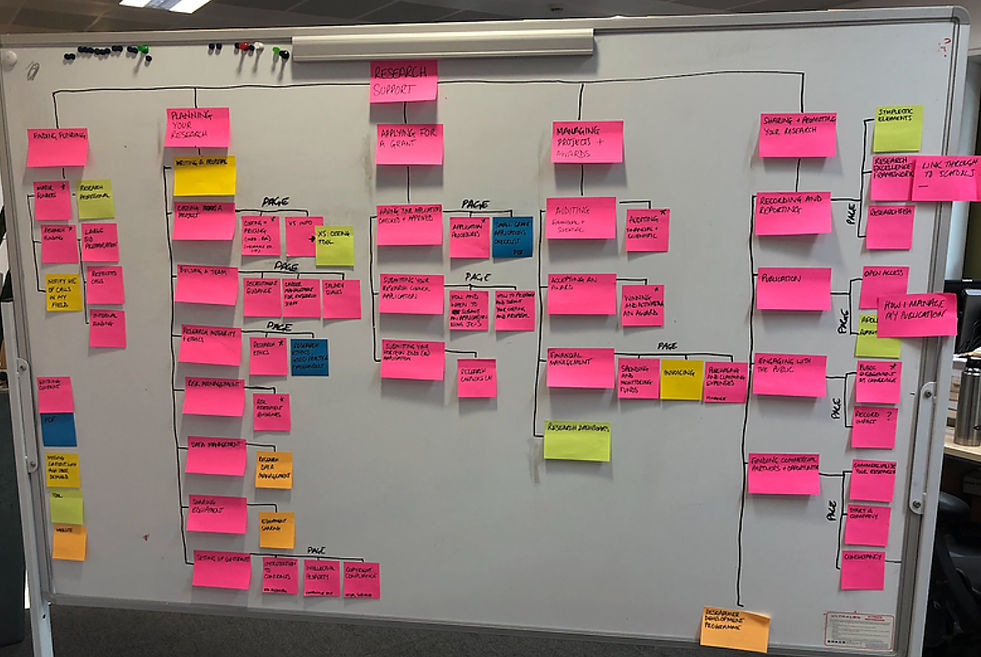My Portfolio / Information Architecture / Researcher Landing Page
Designing a landing page based on user mental models
Aim: Inform the content and structure of a landing page for academic researchers at the University of Cambridge (UoC) that aligns with their expectations of the research lifecycle whilst also adhering to the processes established by the Research Office (RO).
Principal Investigators (PI) at the UoC struggle to find the resources they need that are relevant to the research lifecycle. Resources, distributed across the Research Office (RO) website, are managed by several stakeholders. This affects the PI's relationship with the RO, and their ability to conduct and manage their research effectively and efficiently. I conducted research to evaluate the idea of creating a landing page from which researchers could navigate to relevant resources, and made suggestions for structuring a landing page that would make sense to PIs.
Problem
Process
1
Create mockups for testing
Lo-fi layouts for a researcher landing page were created based on results from the following:
-
Content audit of the RO website.
- Competitor analysis of other Russel Group Universities.
- Stakeholder workshop to garner insight into how and why existing online resources were grouped as they were.
2
Conduct card-sorting interviews with PIs
PIs were interviewed and presented with paper mockups of the proposed landing page structure, which included a Research Project Lifecycle, supplemented with Quick Links. Using these, I planned, conducted, and analysed the results of interviews with PIs at the university that included a card sorting task to identify and organise the content needed to help users (PIs) find what they need.
Results
I conducted interviews included card-sorting exercises to assess the structure of a landing page based on user (PI) mental models. Two forms of data were collected:
-
Participant comments and answers to open-ended questions.
-
Card sort outcomes, including the frequency of card pairings and of similar labels for groups, as well as photographs of the outcomes.
Navigation and search needs
-
The university website was difficult to navigate and time-consuming to use.
-
Instead of using the UoC website, PIs relied on Google, bookmarks, and links sent to them in emails to find what they needed.
-
Participants expressed a need for a better way to find the right person to contact for particular problems and enquiries.
Quick link findings
-
Quick links tended to be grouped into "pre", "during", and "post" getting a grant or running a research project.
-
Quick links were often grouped by activities PIs "would do" and "wouldn't/didn't want to do".
-
Impact-tracking resources, in particular, were considered redundant.
Research lifecycle findings
-
Research activities are iterative and often occur in parallel.
- The concept of a Research Project Lifecycle was too restrictive, and potentially confusing or frustrating.
- There were two very different types of concern, reflected in the images and quotes below:
- Getting and managing grants.
- Doing the research.

So, do you want to [...] have a lifecycle of administration or do you want to have a lifecycle of research as well?
Research output will happen throughout. Really, you've got "applying" and "doing" [...] Outputs are part of "doing".
I think it's fine to have them [research output and grant management] as separate stages, but they happen at the same time.
Outcomes
The card-sorting activities highlighted a notable deviation from the clearcut "lifecycle" proposed by the RO, and a lack of consensus about what a list of Quick Links should include. Based on levels of agreement and similarity matrices (calculated using OptimalSort by Optimal Workshop), I merged the concepts of the Research Project Lifecycle and Quick Links into a simpler set of groups representing three key activities:
-
Planning research (“Develop a project”)
-
Managing grants (“Manage grants and finances”)
-
Doing research ("Manage a project")
The interviews confirmed frustration with navigation of the UoC website, but also that a landing page consisting of an interactive Research Project Lifecycle supplemented with Quick Links was not the logical solution for researchers because: (a.) it wasn't in line with the mental models of PIs; and (b.) it would replicate the same internal processes that resulted in tension between researchers and the RO.
The card sorts formed the basis of a mock-up of the landing page (called Research Support), including a new group called "Build a team", which emerged from the semi-structured interviews.
Lists of relevant sources of support are included at the bottom of each column based on user needs for finding someone to contact for support in particular activities.
We additionally collected task scenarios to be used in a subsequent study for testing the conclusions coming out of these card sorts. We used this research as a basis for a new proposed information architecture for the RO website as a whole (see Challenges and learnings, below).

Challenges and learnings
The main challenge lay in aligning the RO's expectations of how content should be organised with the PIs' mental models of the research process. The need for an additional 'landing page', structured in line with the internal processes of the RO, was hotly contested by PIs. We used this insight to get buy-in for (research-supported) content and a new web strategy, as opposed to adding a page to an already saturated web infrastructure.

